Amazon, Walmart Face Retail Industry Slump and Stalled Grocery

A week of soft holiday season sales data combined with fresh cautious commentary from competitors could spark a strategic shift among the top-two retailers this year, as household spending and habits aren’t responding to the same old tricks as they once did.
Not only did the all-important December retail sales data deliver a clunker this week, falling 1.1% for its biggest monthly decline in a year, but the benchmark’s stalwart non-discretionary grocery category stalled too, after benefitting from belt-tightening and sharp food price increases all year.
“The continued uncertainty around the macroeconomic environment has proven to be more difficult for retailers to weather as many consumers are more hesitant to spend in comparison to 2021 holiday spending,” Mike Rittler, head of Retail Card Services at TD Bank, told PYMNTS after the government report was announced, stressing the need for retailers to revisit the lessons learned from the pandemic.
“It is now more important than ever to prioritize the customer service experience in line with supply chain management,” Rittler added.
The Bare Shelf Experience
While the consumer preference shift toward food, groceries and essentials — and away from spending on discretionary items — handed Walmart its best year of relative outperformance versus Amazon in over a decade in 2022, the scant 0.1% increase in grocery store sales last month suggests something is amiss.
This, as the annualized pace of inflation surrounding food eaten at home — as reported earlier this month — is still running in the double digits.
Although consumers still clearly have a defensive bias, and meals are still being eaten at home, the low-margin traffic leader that grocery normally is starts to lose some of its punch, a reality that is especially poignant for Walmart, the nation’s largest retailer of groceries.
Further complicating this cautionary consumer calculus were comments from Procter & Gamble CEO Jon Moeller this week, who said from his seat, the view of both shoppers and retailers was stable, despite widespread reports that people were trading down to cheaper store brands or private labels.
“Don’t forget, our retail partners are the owners of the private-label brands that we compete against, and they’re facing many of the same dynamics in terms of their cost inputs that we are,” Moeller told P&G investors on the CPG-giant’s fiscal second-quarter earnings call, reporting that the buying habits of his biggest customers and ongoing fluctuation of inventory had not changed.
“I don’t see anything in my interactions with our retail partners that causes an inflection of that discussion in the near term,” Moeller added.
As for Amazon and Walmart specifically, it is probably too early to say that the highly promotional pricing response to last year’s glut of unsold inventory and budget-crushing inflation is over, as PYMNTS data has shown that consumers’ economic outlooks are a lot more pessimistic than those of government policymakers and many Wall Street pundits.
One retail adjustment that may see further uptake, for example, is non-promotional efforts aimed at driving store traffic, such as Amazon’s expanding no-box return program in Whole Foods locations.
“As our customers’ needs evolve, we evolve with them to ensure we’re exceeding expectations and delivering ‘WOW,’ at every step,” Zappos.com CEO Scott Schaefer said in a statement announcing the expansion of the “label-free, box-free” in-store return program. “… [W]e’re excited to not only be better serving our customers, but also to have found a natural partner in Whole Foods Market.”
What is known for sure is that two weeks from now, investors will find out how Amazon’s promotional, cross-selling and belt-tightening efforts are working, as the Seattle-based eCommerce leader confirmed its fourth-quarter earnings results and conference call will take place after the close of trading Feb.2.
For all PYMNTS retail coverage, subscribe to the daily Retail Newsletter.
